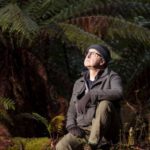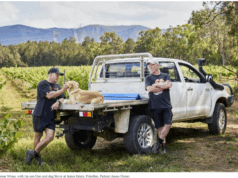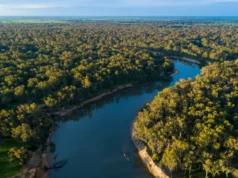Photo credit: Remi Chauvin
It was right on dusk, in the middle of winter this year, when three cavers emerged from a day of exploring the dolomite catacombs of Hastings Caves in southern Tasmania and stumbled on a scene that left them at first dumbfounded, then incredulous. A group of people were sitting on stumps among the towering stringybarks — some in a seemingly trancelike state — while an inexplicable cacophony of birds roosting ricocheted around the forest. It looked like some sort of pagan ritual.
“What the bloody hell do you think you’re doing?” cried the cavers, or words to that effect, on realising the birds were not real but some sort of recording.
What the cavers’ ears had been drawn to was in fact an artwork titled Hrafn: Conversations with Odin. First opening during MONA’s Dark Mofo festival in June, Hrafn (which rhymes approximately with “larfin’”) has been granted an extended season as part of Project X, a series of immersive public artworks designed to bring people back to Tasmania’s Huon Valley and stimulate the region financially and culturally after last summer’s devastating bushfires. A second artwork titled The Aftermath Dislocation Principle by British artist Jimmy Cauty, featuring a miniature dystopian town inside a shipping container, is touring the region, unleashing thought-provoking fringe art on towns such as Geeveston, Dover (where it currently is), Southport, Franklin, Huonville and Cygnet.
While bushfires destroyed more than 200,000ha across Tasmania, the Huon Valley was particularly hit hard due to the smouldering mess left of its only major tourist attraction, the Tahune Airwalk, which brings in about 80,000 people a year. In a shrewd example of thinking outside the box, the arts sector was ushered in to help bind the wound and direct the healing.
The federal government stumped up $1.5m and Tourism Tasmania another $500,000. Project X is curated by DarkLab, MONA’s creative projects arm, which perhaps explains the rather left field approach to art that so perplexed the cavers who chanced on Hrafn. The artwork is from British sound artist Chris Watson. You might not have heard of Watson but you would have almost certainly heard his work. He has been David Attenborough’s right-hand man for more than 20 years, recording the audio of wildlife for documentaries such as The Secret Life of Mammals, The Secret Life of Birds and Frozen Planet…
Read the full story here



